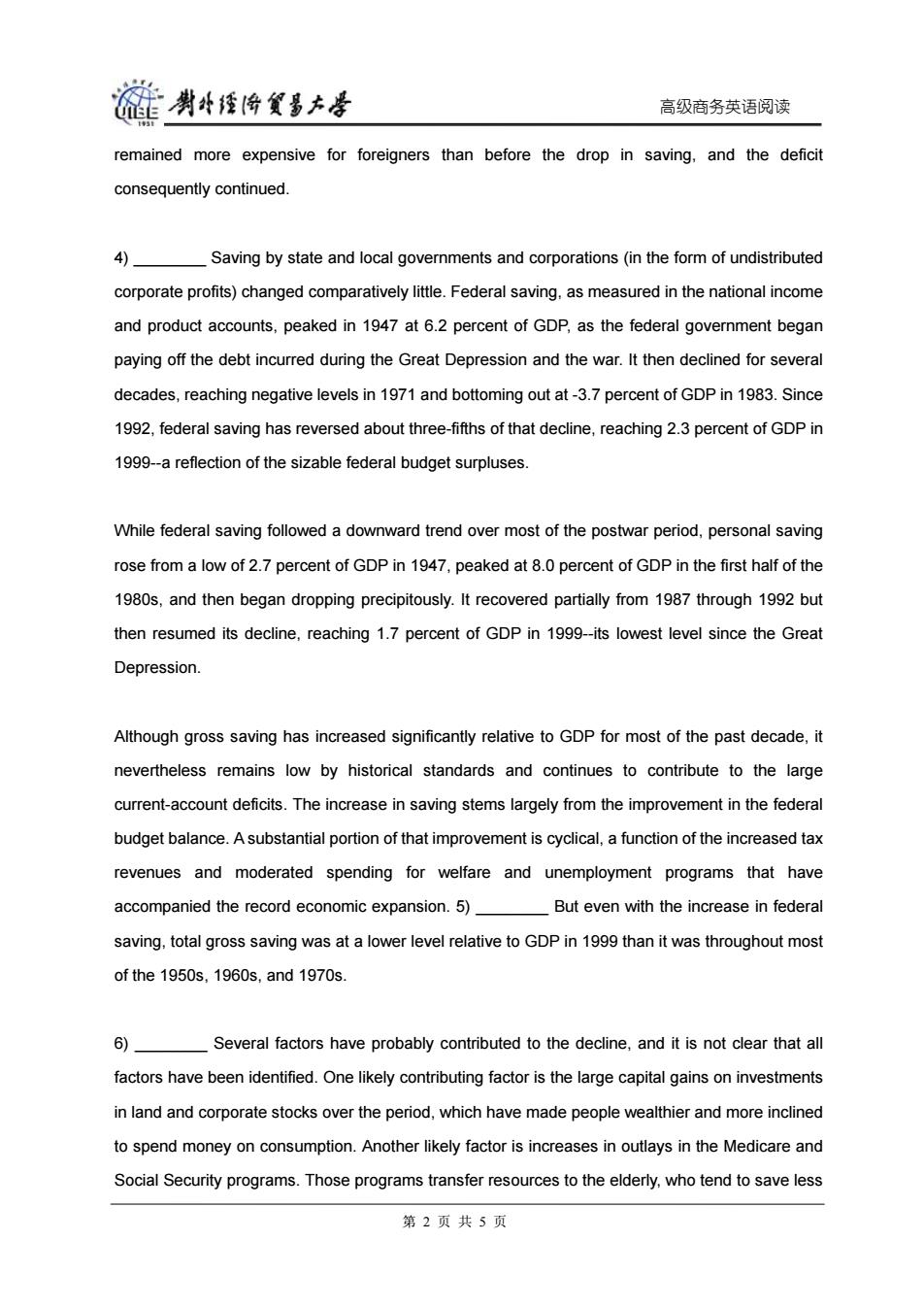正在加载图片...

碰肖经海食昌大是 高级商务英语阅读 remained more expensive for foreigners than before the drop in saving,and the deficit consequently continued. 4) Saving by state and local governments and corporations(in the form of undistributed corporate profits)changed comparatively little.Federal saving,as measured in the national income and product accounts,peaked in 1947 at 6.2 percent of GDP,as the federal government began paying off the debt incurred during the Great Depression and the war.It then declined for several decades,reaching negative levels in 1971 and bottoming out at-3.7 percent of GDP in 1983.Since 1992,federal saving has reversed about three-fifths of that decline,reaching 2.3 percent of GDP in 1999--a reflection of the sizable federal budget surpluses. While federal saving followed a downward trend over most of the postwar period,personal saving rose from a low of 2.7 percent of GDP in 1947,peaked at 8.0 percent of GDP in the first half of the 1980s,and then began dropping precipitously.It recovered partially from 1987 through 1992 but then resumed its decline,reaching 1.7 percent of GDP in 1999--its lowest level since the Great Depression. Although gross saving has increased significantly relative to GDP for most of the past decade,it nevertheless remains low by historical standards and continues to contribute to the large current-account deficits.The increase in saving stems largely from the improvement in the federal budget balance.A substantial portion of that improvement is cyclical,a function of the increased tax revenues and moderated spending for welfare and unemployment programs that have accompanied the record economic expansion.5) But even with the increase in federal saving,total gross saving was at a lower level relative to GDP in 1999 than it was throughout most of the 1950s,1960s,and 1970s. 6) Several factors have probably contributed to the decline,and it is not clear that all factors have been identified.One likely contributing factor is the large capital gains on investments in land and corporate stocks over the period,which have made people wealthier and more inclined to spend money on consumption.Another likely factor is increases in outlays in the Medicare and Social Security programs.Those programs transfer resources to the elderly,who tend to save less 第2页共5页高级商务英语阅读 remained more expensive for foreigners than before the drop in saving, and the deficit consequently continued. 4) ________ Saving by state and local governments and corporations (in the form of undistributed corporate profits) changed comparatively little. Federal saving, as measured in the national income and product accounts, peaked in 1947 at 6.2 percent of GDP, as the federal government began paying off the debt incurred during the Great Depression and the war. It then declined for several decades, reaching negative levels in 1971 and bottoming out at -3.7 percent of GDP in 1983. Since 1992, federal saving has reversed about three-fifths of that decline, reaching 2.3 percent of GDP in 1999--a reflection of the sizable federal budget surpluses. While federal saving followed a downward trend over most of the postwar period, personal saving rose from a low of 2.7 percent of GDP in 1947, peaked at 8.0 percent of GDP in the first half of the 1980s, and then began dropping precipitously. It recovered partially from 1987 through 1992 but then resumed its decline, reaching 1.7 percent of GDP in 1999--its lowest level since the Great Depression. Although gross saving has increased significantly relative to GDP for most of the past decade, it nevertheless remains low by historical standards and continues to contribute to the large current-account deficits. The increase in saving stems largely from the improvement in the federal budget balance. A substantial portion of that improvement is cyclical, a function of the increased tax revenues and moderated spending for welfare and unemployment programs that have accompanied the record economic expansion. 5) ________ But even with the increase in federal saving, total gross saving was at a lower level relative to GDP in 1999 than it was throughout most of the 1950s, 1960s, and 1970s. 6) ________ Several factors have probably contributed to the decline, and it is not clear that all factors have been identified. One likely contributing factor is the large capital gains on investments in land and corporate stocks over the period, which have made people wealthier and more inclined to spend money on consumption. Another likely factor is increases in outlays in the Medicare and Social Security programs. Those programs transfer resources to the elderly, who tend to save less 第 2 页 共 5 页